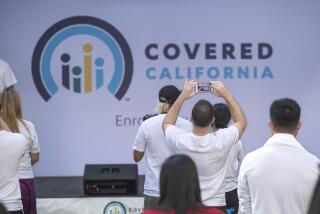Rand’s Obamacare stats: 9.3 million new insureds, and counting

The long-awaited Rand Corp. study of Obamacare’s effect on health insurance coverage was released Tuesday and confirmed the numbers that had been telegraphed for more than a week: At least 9.3 million more Americans have health insurance now than in September 2013, virtually all of them as a result of the law.
That’s a net figure, accommodating all those who lost their individual health insurance because of cancellations. The Rand study confirms other surveys that placed the number of people who lost their old insurance and did not or could not replace it -- the focus of an enormous volume of anti-Obamacare rhetoric -- at less than 1 million. The Rand experts call this a “very small” number, less than 1% of the U.S. population age 18 to 64.
The Rand study was eagerly anticipated in part because of the dearth of hard information from other sources, including the federal and state governments, which are still compiling their statistics and may not have a full slate for months.
Rand acknowledges that its figures have limitations -- they’re based on a survey sampling, meaning that the breakdowns are subject to various margins of error, and they don’t include much of the surge in enrollments in late March and early April. Those 3.2-million sign-ups not counted by Rand could “dramatically affect” the figures on total insureds, the organization said.
A few other important takeaways:
--The number of people getting insurance through their employers increased by 8.2 million. Rand said the increase is likely to have been driven by a decline in unemployment, which made more people eligible for employer plans, and by the incentives in the Affordable Care Act encouraging more employer coverage. The figure certainly undermines the contention by the healthcare law’s critics that the legislation gave employers an incentive to drop coverage.
--Of the 3.9 million people counted by Rand as obtaining insurance on the individual exchange market, 36% were previously uninsured. That ratio is expected to rise when the late signups are factored in. Medicaid enrollment increased by 5.9 million, the majority of whom did not have insurance before signing up.
--These figures are only the leading edge of a long-term trend. “It’s still early in the life of the ACA,” Rand said. Its experts expect more enrollments “as people become more familiar with the law, the individual mandates increase to their highest levels, the employer mandate kicks in, and other changes occur.” But their bottom line is that the law already has led to “a substantial increase in insurance coverage.”
More to Read
Inside the business of entertainment
The Wide Shot brings you news, analysis and insights on everything from streaming wars to production — and what it all means for the future.
You may occasionally receive promotional content from the Los Angeles Times.











